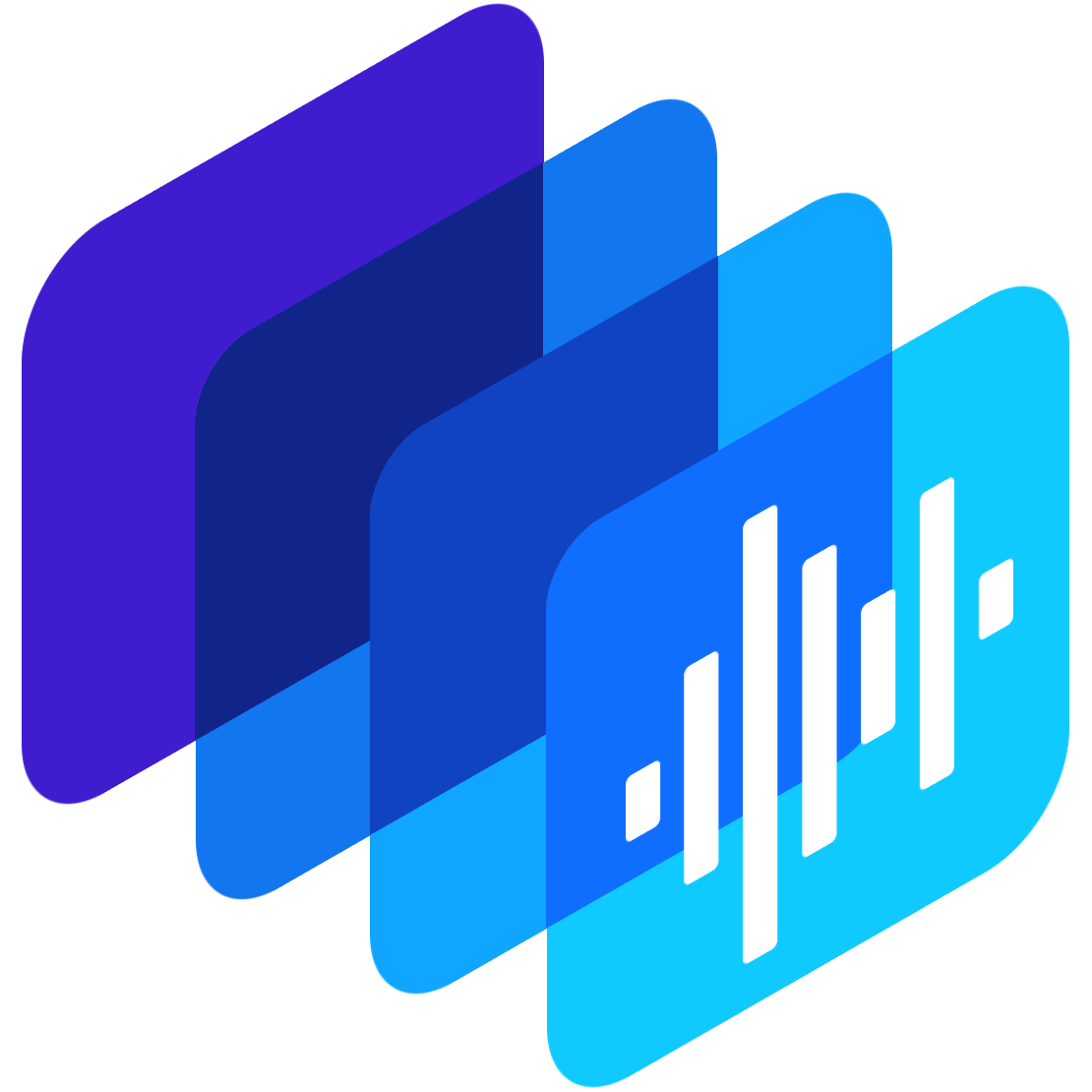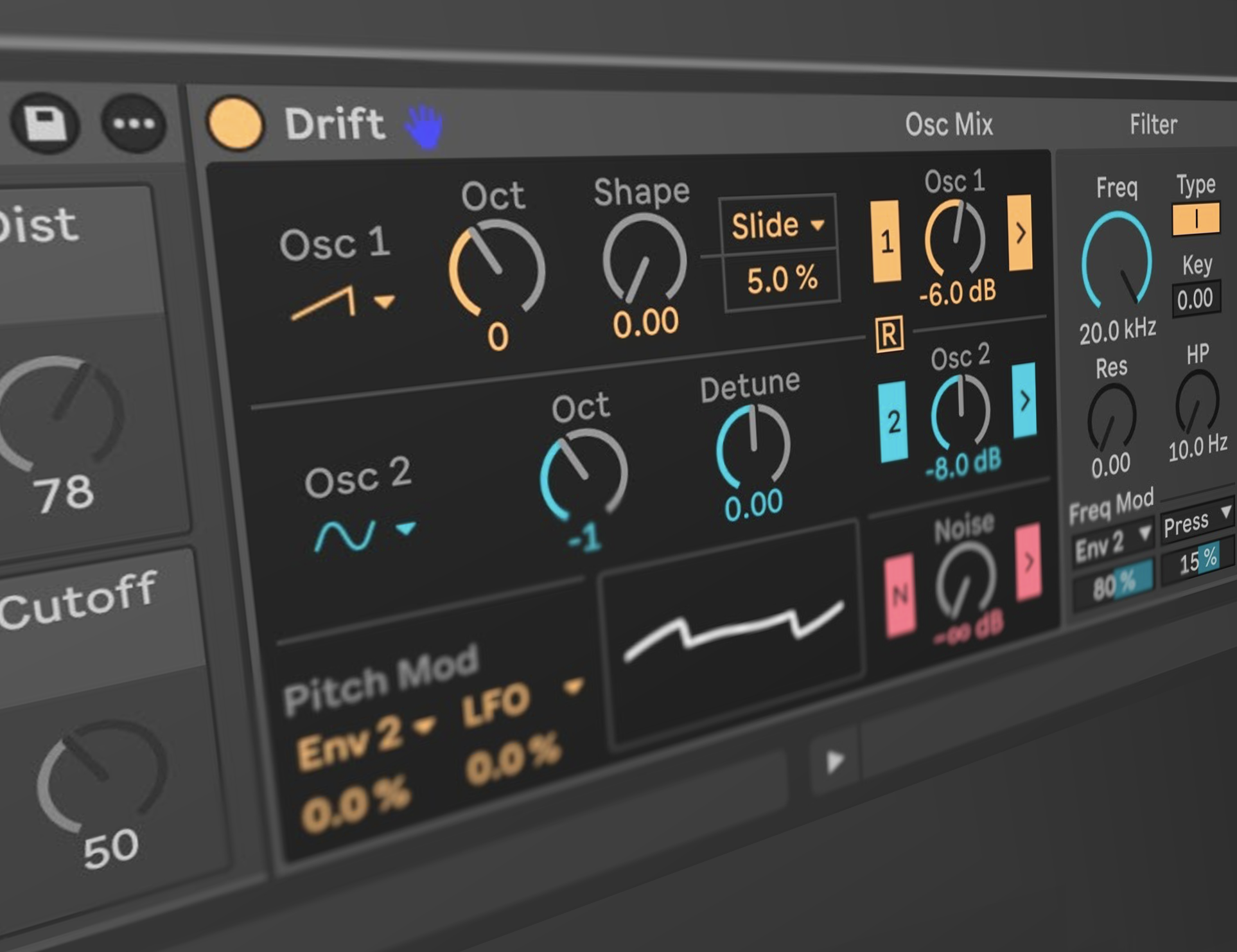

Ableton Drift is a relatively recent addition to the Live ecosystem, but it’s become a go-to synth for fast, expressive sound design. Lightweight and easy to navigate, Drift offers a focused subtractive architecture that feels familiar to producers comfortable with analog synths, while still offering enough flexibility to shape detailed basslines, leads, and textures. It’s included in all versions of Live 11.3 and above, meaning anyone working in Live already has access to it. For users of Beat Shaper, this opens up a seamless path from AI-generated MIDI loops to polished sounds in Live, since Beat Shaper exports Drift-compatible patches alongside every generated sequence.
Drift is a compact virtual-analog synthesizer developed by Ableton and introduced with Live 11.3 in 2023. It draws from classic subtractive designs, with a straightforward layout and intentionally limited feature set that emphasizes speed, clarity, and musical results. The architecture centers on two oscillators capable of continuous shape morphing. These are fed into a filter section with two distinct filter models, a dedicated high-pass filter, and a drive circuit for adding harmonic richness.
What sets Drift apart from other built-in Live devices is its focus on movement and character. The namesake "drift" parameter introduces subtle instability by randomizing pitch and filter cutoff slightly on a per-voice basis, emulating the natural imperfections of hardware analog gear. Combined with envelope shaping, LFO modulation, and a basic modulation matrix, Drift provides just enough control to carve out expressive, lively tones without overwhelming the interface. It’s equally suited for simple basses or layered textures, and it loads quickly and runs smoothly even in large projects.
Drift’s layout mirrors the flow of a classic analog synth but trims it down to the essentials. The two oscillators cover the full range of subtractive synthesis basics, offering continuously variable shapes and features like pulse width modulation. A mixer section balances the oscillators before they reach the filter stage, where users can choose between two filter models and add drive or high‑pass shaping to sculpt the tone further.
Modulation stays straightforward but effective. Envelopes handle amplitude and filter dynamics, while an LFO can target key parameters for movement over time. Together with the drift control, these tools make it easy to create patches that feel organic and animated without introducing unnecessary menu diving.
Drift is included in all editions of Ableton Live 11.3 and later, including Lite, Standard, and Suite. This means it’s available out of the box for nearly every Live user, with no need for additional downloads or instruments.
Beyond the desktop, Drift has also been integrated into Ableton’s mobile and hardware platforms. With the introduction of preset export in Live 12.1, Drift patches created on desktop can be used in sets on Ableton Note (iOS) and Move, the standalone performance device. These platforms now support full parameter access for Drift, making it possible to edit and perform with the same sounds across devices. This portability makes Drift a consistent option throughout the Ableton ecosystem, whether building tracks in the studio or performing them live.
Ableton Live includes several synthesizers, each designed with different sound design goals in mind. Drift’s role in this lineup is to provide a fast, accessible subtractive synth that sounds musical by default. That makes it a practical starting point for sketching and collaboration, especially when portability and compatibility are important.
In contrast, Operator, one of Ableton's other popular devices, is a hybrid FM and additive synthesizer built for more complex harmonic shaping. Its four-operator architecture and flexible routing make it better suited to metallic timbres, digital percussion, and evolving harmonic content. Analog, on the other hand, focuses on emulating the behavior of classic analog hardware, with component-modeled filters and amplifiers that respond in subtle, expressive ways.
Meld, introduced in Live 12, is the most feature-rich of the group. It combines two independent engines with a deep modulation matrix, built-in effects, and support for layered or generative textures. While Drift keeps things intentionally simple, Meld is designed for building complex, evolving patches.
For many everyday production tasks, Drift offers a streamlined option for quick tweaking. It doesn’t replace Operator, Analog, or Meld entirely, but complements them as a lightweight, subtractive option that fits cleanly into modern workflows across devices.
While synths like Massive and Serum are known for their deep wavetable engines and extensive modulation options, Drift takes a more straightforward approach: its subtractive architecture and low setup overhead make it well suited for core elements like basses, leads, and pads.
Rather than competing with more complex third-party instruments, Drift complements them by handling foundational parts efficiently. For producers using Beat Shaper, the integration is direct: each generated MIDI loop comes with a matching Drift patch, making it easy to move ideas into Live without needing external plugins or additional configuration.
Modern production often demands speed, portability, and consistency across environments. Drift fits this workflow well. It balances speed with flexibility for foundational parts and textures. Its intentionally minimal design helps avoid distraction. There’s just enough depth to shape a sound with character, but not so much complexity that it slows down the process.
Because it’s included in every edition of Live, Drift is a reliable tool for collaboration. Producers working with different versions of Live don’t need to worry about missing plugins or broken patches. And thanks to its presence on Note and Move, ideas created in a studio session can be edited or performed later on a mobile device or standalone hardware. This integration makes Drift a practical choice for producers working across different setups.
At the time of writing, Beat Shaper generates short musical loops intended as raw material for further development in a DAW. These loops can be exported as MIDI files, and for melodic parts, each MIDI export includes a corresponding Drift patch. This allows users to bring both the notes and the sound into Ableton Live with minimal setup. More information about using Beat Shaper together with Ableton Live can be found on the Ableton Compatibility page.
Users can also tweak sound parameters directly in Beat Shaper before exporting. Filter settings, envelope shapes, oscillator behavior, and other sound design controls can be adjusted in the browser, and the exported Drift patch will reflect those changes while remaining fully compatible with Live, Move, and Note.
It’s important to note that Drift and Beat Shaper use different underlying synthesizer architectures. While the exported patches are designed to approximate the sound heard inside Beat Shaper, they are not identical reproductions. Certain tonal details and behaviors may differ slightly due to how the two systems interpret synthesis. Even so, the patches preserve the overall character and intent of the generated loop, allowing users to stay in the same creative space as they transition into arrangement and production.
Drift stands out as a compact, expressive synthesizer that fits naturally into modern workflows. Its focused subtractive architecture, subtle analog-style movement, and wide compatibility across Live, Move, and Note make it a versatile tool for both sketching ideas and finishing tracks. Because it’s available in every edition of Live, it also removes many of the barriers that typically come with plugin-based collaboration or version mismatches.
Beat Shaper builds on this accessibility by generating MIDI loops together with Drift patches that carry the intended tone into Live. This pairing lets producers move instantly from AI-generated ideas to editable sessions, with both the musical content and the sound ready to use. It eliminates the friction of trying to match a synth preset to a loop after the fact.
For producers looking to explore new ideas quickly, or for those working across devices and setups, this integration offers a fast and practical way to build out sessions. Beat Shaper provides the structure, Drift supplies the tone, and the handoff between them is built to keep creative momentum going.
Ableton and Live are trademarks of Ableton AG.
Enhance creativity and break through creative blocks